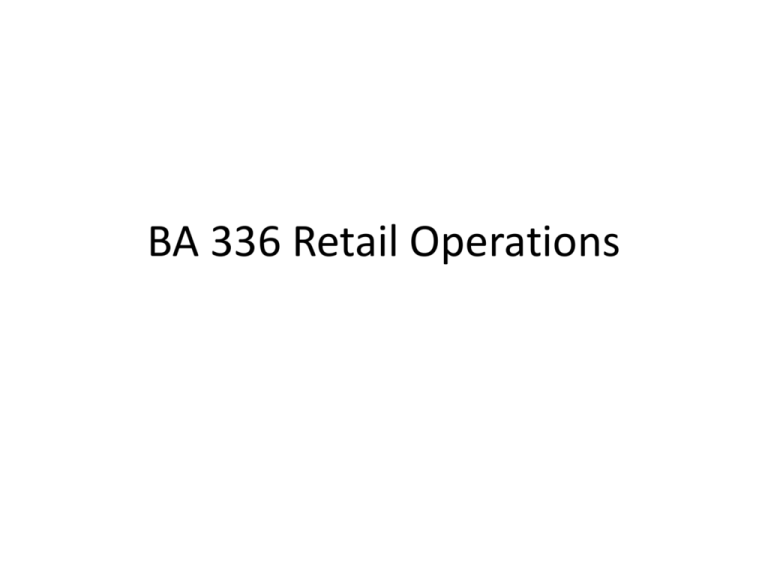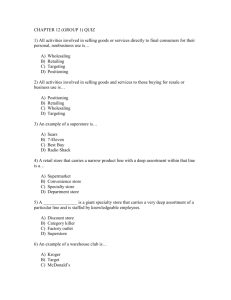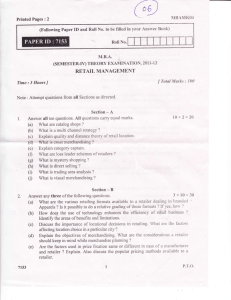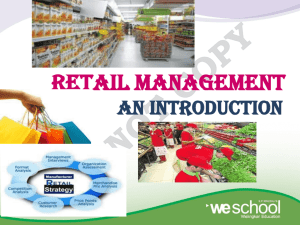
BA 336 Retail Operations
Four Characteristics of
Services Retailing
•
•
•
•
Intangibility
Inseparability
Perishability
Variability
Characteristics of
Service Retailing
Intangibility
• No patent protection possible
• Difficult to display/communicate
service benefits
• Quality judgment is subjective
• Some services involve
performances/experiences
Characteristics of
Service Retailing
Inseparability
• Consumer may be involved in
service production
• Centralized mass production difficult
• Consumer loyalty may rest
with employees
Characteristics of
Service Retailing
Perishability
• Services cannot be inventoried
• Lost revenues from unsold services are lost forever
• Effects of seasonality can be severe
• Planning employee schedules can be complex
• Need to balance supply and demand
(yield management pricing)
Characteristics of
Service Retailing
Variability
• Standardization and quality control hard
to achieve
• Customers may perceive variability even
when it does not actually occur
• Need to industrialize/mechanize/service
blueprint services to factor out variability
Elements of a Retail Strategy
Retail Strategy
Components of Internal Analysis
Figure 3.2
Copyright © 2004 SouthWestern. All rights reserved.
3–8
Resources, Capabilities and Core Competencies
• Resources
– Are a firm’s assets,
including people and the
value of its brand name
– Represent inputs into a
firm’s production process,
such as:
•
•
•
•
•
Copyright © 2004 SouthWestern. All rights reserved.
3–9
Capital equipment
Skills of employees
Brand names
Financial resources
Talented managers
Resources, Capabilities and Core Competencies
• Resources
– Tangible resources
•
•
•
•
Financial resources
Physical resources
Technological resources
Organizational resources
– Intangible resources
• Human resources
• innovation resources
• Reputation resources
Copyright © 2004 SouthWestern. All rights reserved.
3–10
Tangible Resources
Financial Resources
•
The firm’s borrowing capacity
•
The firm’s ability to generate internal
funds
Organizational Resources
•
The firm’s formal reporting structure
and its formal planning, controlling,
and coordinating systems
Physical Resources
•
Sophistication and location of a firm’s
plant and equipment
•
Access to raw materials
Technological Resources
•
Stock of technology, such as patents,
trade-marks, copyrights, and trade
secrets
SOURCES: Adapted from J. B. Barney, 1991, Firm resources and
sustained competitive advantage, Journal of Management, 17: 101; R.
M. Grant, 1991, Contemporary Strategy Analysis, Cambridge, U.K.:
Blackwell Business, 100–102.
Copyright © 2004 SouthWestern. All rights reserved.
Table 3.1
3–11
Intangible Resources
Human Resources
• Knowledge
• Trust
• Managerial capabilities
• Organizational routines
Innovation Resources
• Ideas
• Scientific capabilities
• Capacity to innovate
Reputational Resources
• Reputation with customers
• Brand name
• Perceptions of product quality,
durability, and reliability
• Reputation with suppliers
• For efficient, effective, supportive, and
mutually beneficial interactions and
relationships
SOURCES: Adapted from R. Hall, 1992, The strategic analysis of
intangible resources, Strategic Management Journal, 13: 136–139; R.
M. Grant, 1991, Contemporary Strategy Analysis, Cambridge, U.K.:
Blackwell Business, 101–104.
Copyright © 2004 SouthWestern. All rights reserved.
Table 3.2
3–12
Applying the Retailing Concept
Customer Orientation
Coordinated Effort
Retailing
Concept
Value-driven
Goal Orientation
Retail
Strategy
Components of Strategic Planning
• Strategic planning - Adapting the resources of
the firm to the opportunities and threats of an
ever-changing retail environment.
• Through the proper use of strategic planning,
retailers hope to achieve and maintain a
balance between resources available and
opportunities ahead.
LO 1
Components of Strategic Planning
• Strategic planning consists of four components:
– Development of a mission (or purpose) statement for
the firm.
– Definition of specific goals and objectives for the firm.
– S(strengths)W(weaknesses)O(opportunities)T(threats)
analysis.
– Development of basic strategies that will enable the
firm to reach its objectives and fulfill its mission.
LO 1
Mission Statement
• It is a basic description of the fundamental
nature, rationale, and direction of the firm.
• Elements of a mission statement are:
– How the retailer uses or intends to use its
resources.
– How it expects to relate to the ever-changing
environment.
– The kinds of values it intends to provide in order
to serve the needs and wants of the consumer.
LO 1
Statement of Goals and Objectives
• Provide:
– Specific direction and guidance to the firm in the
formulation of its strategy.
– A control mechanism by establishing a standard
against which the firm can measure and evaluate
its performance.
LO 1
Retail Objectives
LO 1
Statement of Goals and Objectives
• Market performance objectives
– Establish the amount of dominance the retailer
seeks in the marketplace.
– Market share - The retailer’s total sales divided by
total market sales.
LO 1
Statement of Goals and Objectives
• Financial objectives
– Profit-based objectives - Deal directly with the
monetary return a retailer desires from its business.
– Profit is the aggregate total of net profit after taxes—
that is, the bottom line of the income statement.
– Profit can be expressed as a percentage of net sales.
– It can also be defined in terms of return on investment
(ROI), which can be defined by—Return on assets
(ROA) and Return on net worth (RONW).
LO 1
Strategic Profit Model
LO 1
Statement of Goals and Objectives
• Financial objectives
– Stockouts - Products that are out of stock and
therefore unavailable to customers when they
want them.
LO 1
Statement of Goals and Objectives
• Financial objectives
– Productivity objectives - State the sales objectives
that the retailer desires for each unit of resource
input.
• Space productivity - Net sales divided by the total square
feet of retail floor space.
• Labor productivity - Net sales divided by the number of fulltime–equivalent employees.
• Merchandise productivity - Net sales divided by the average
dollar investment in inventory.
– Productivity objectives are vehicles by which a retailer
can program its business for high-profit results.
LO 1
• Open or acquire on store over the next four
years
• Remodel one existing store every three years
• Increase operating profit margin in each story
by .25 percent for each six-month period
• Increase clothing sales in existing stores by 10
percent over the preceding year
Strategies
• Are a carefully designed plan for achieving the
retailer’s goals and objectives.
• Retailers can operate with three strategies:
– Get shoppers into your store.
– Convert these shoppers into customers by having
them purchase merchandise.
– Implement the above two strategies at the lowest
operating cost possible that is consistent with the
level of service that your customers expect.
LO 1
SWOT Analysis
• Strengths:
– What major competitive advantage(s) do we
have?
– What are we good at?
– What do customers perceive as our strong points?
– Ikea
– Target
– McDonald's
LO 1
SWOT Analysis
• Weaknesses
– What major competitive advantage(s) do
competitors have over us?
– What are competitors better at than we are?
– What are our major internal weaknesses?
– Ikea
– Target
– McDonald's
LO 1
SWOT Analysis
• Opportunities
– What favorable environmental trends may benefit
our firm?
– What is the competition doing in our market?
– What areas of business that are closely related to
ours are undeveloped?
– Ikea
– Target
– McDonald's
LO 1
SWOT Analysis
• Threats
– What unfortunate environmental trends may hurt
our future performance?
– What technology is on the horizon that may soon
have an impact on our firm?
LO 1
Building competitive advantage
•
•
•
•
•
Physical differentiation
The selling process
After-purchase satisfaction
Location
Never being out of stock
Strategies
• The retailer must develop a retail marketing
strategy with strong financial elements.
• A fully developed marketing strategy should
address the following considerations: the
specific target market, location, the specific
retail mix that the retailer intends to use, and
the retailer’s value proposition.
LO 1
Strategies
• Target market - Group of customers that the
retailer is seeking to serve.
• Location - Geographic space or cyberspace
where the retailer conducts business.
• Retail mix - Combination of merchandise,
price, advertising and promotion, location,
customer service and selling, and store layout
and design.
LO 1
Strategies
• Value proposition - A clear statement of the
tangible and/or intangible results a receives
from shopping at and using the retailer’s
products or services.
LO 1
What is Value? (cont.)
Channel
Perspective
• Value is a series
of activities and
processes (the
“value chain”)
that provide a
certain value for
the consumer.
Customer
Perspective
• Value is a perception
that the shopper has of
the value chain.
• It is the view of all the
benefits from a
purchase versus the
price paid.
Value and value chain…
Value Chain (Porter,1985)
Role: disaggregates a firm into its strategically relevant
activities in order to identify and understand sources of
competitive advantages
The value chain is unique to each business
…Competing in a business involves performing a set of
discrete activities, in which competitive advantage
resides
The Value Chain
• An analytical tool that describes all
activities that make up the economic
performance and capabilities of the firm.
• It is used to analyze and examine
activities that create value for a given
firm.
Copyright © 2004 SouthWestern. All rights reserved.
3–38
Service
Marketing and Sales
Outbound Logistics
Procurement
Technological Development
Human Resource Management
Firm Infrastructure
The Basic Value
Chain
Operations
Inbound Logistics
Identifying the Value Chain
Value
Support
Activities
What buyers
are willing to
pay
Primary Activities
Value Chain Analysis
• Allows the firm to understand the parts of its
operations that create value and those that do
not
• A template that firms use to:
– Understand their cost position
– Identify multiple means that might be used to
facilitate implementation of a chosen businesslevel strategy
Copyright © 2004 SouthWestern. All rights reserved.
3–40
Value Chain Analysis (cont’d)
• Primary activities involved with:
– A product’s physical creation
– A product’s sale and distribution to buyers
– The product’s service after the sale
• Support activities
– Provide the support necessary for the primary
activities to take place
Copyright © 2004 SouthWestern. All rights reserved.
3–41
Value Chain Analysis (cont’d)
• Value chain
– Shows how a product moves from raw-material stage
to the final customer
• To be a source of competitive advantage, a
resource or capability must allow the firm:
– To perform an activity in a manner that is superior to
the way competitors perform it, or
– To perform a value-creating activity that competitors
cannot complete
Copyright © 2004 SouthWestern. All rights reserved.
3–42
Retail Value Chain
• Represents the total bundle of benefits
offered to consumers through a channel
of distribution
• Store location and parking, retailer ambience,
customer service, brands/products carried,
product quality, retailer’s in-stock position,
shipping, prices, image, and other elements
Retail Value Chain
• Represents the total bundle of benefits
offered to consumers through a channel
of distribution
• Store location and parking, retailer ambience,
customer service, brands/products carried,
product quality, retailer’s in-stock position,
shipping, prices, image, and other elements
A Value-Oriented Retailing Checklist
•
•
•
•
•
Is value defined from a consumer perspective?
Does the retailer have a clear value/price point?
Is the retailer’s value position competitively defensible?
Are channel partners capable of value-enhancing services?
Does the retailer distinguish between expected and
augmented value chain elements?
• Has the retailer identified potential value chain elements?
• Is the retailer’s value-oriented approach aimed at a distinct
market?
• Is the retailer’s value-oriented approach consistent?
Potential Pitfalls to Avoid in Planning
a Value-Oriented Retail Strategy
• Planning value solely from a price perspective
• Providing value-enhanced services that
customers do not want or will not pay extra for
• Competing in the wrong value/price segment
• Believing augmented elements alone create
value
• Paying lip service to customer service
Retail Strategic Planning and
Operations Management Model
LO 2
The Retail Strategic Planning and
Operations Management Model
• Operations management - Deals with
activities directed at maximizing the efficiency
of the retailer’s use of resources. It is
frequently referred to as day-to-day
management.
• The need to strive for a high profit is tied to
the extremely competitive nature of retailing.
LO 2
Merchandising
Types of Merchandise
• Staple Goods – items that are constantly in demand by
customers. Examples are toothpaste, milk, or bread.
– Used consistently and replaced on a regular basis
– Sales are easily predictable because they are bought on a consistent
basis.
• Convenience Goods – small, inexpensive items that customers
purchase frequently. Examples are gum, bottled water, or
magazines.
– Found in convenience stores, grocery stores or gas stations.
• Fashion Goods – items that are popular at a
certain time. An example is clothing.
– Includes any item that comes in or out of style
– Retailer will maximize sales by acquiring the
product as it is gaining popularity
• Seasonal Goods – products that are popular
only at a certain time of year. Examples are
swimsuits, boxed chocolates, or snow skis.
The Merchandise Mix
• Businesses must pay close attention to their
target market and must obtain, develop,
maintain, and continually improve upon their
merchandise mix.
– Components of the Mix
• Merchandise Mix – made up of all the products that a
business sells
• Product Line – a group of closely related products that
a business sells
• Product Items – the products that make up a product
line. A specific model or brand
• Merchandise Mix Strategies
– Development – develop new products to bolster the
company’s image or to expand their market share.
– Expansion – businesses can choose to add either new
product items or new product lines.
– Modification – altering a company’s existing product.
– Deletion – may occur when a product is no longer
useful, obsolete, not fashionable, or room is needed
for another product.
Any questions???








